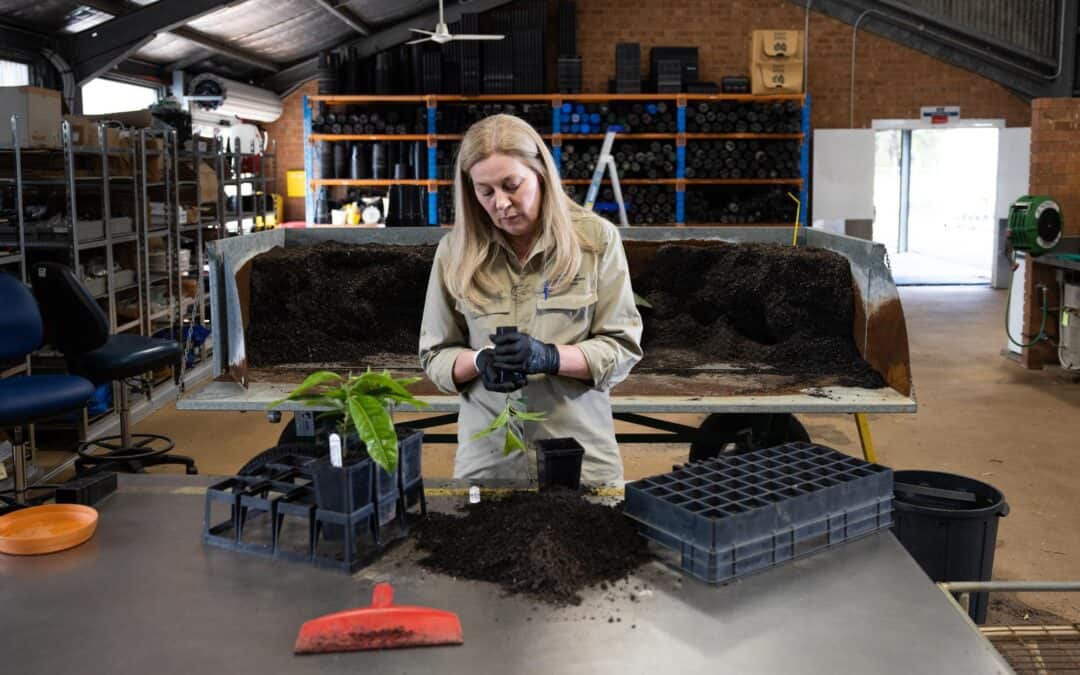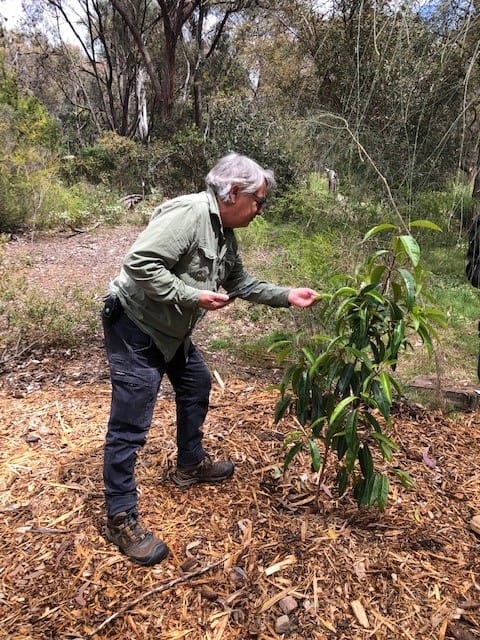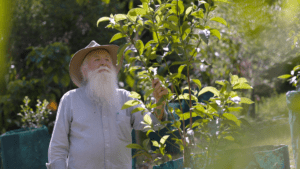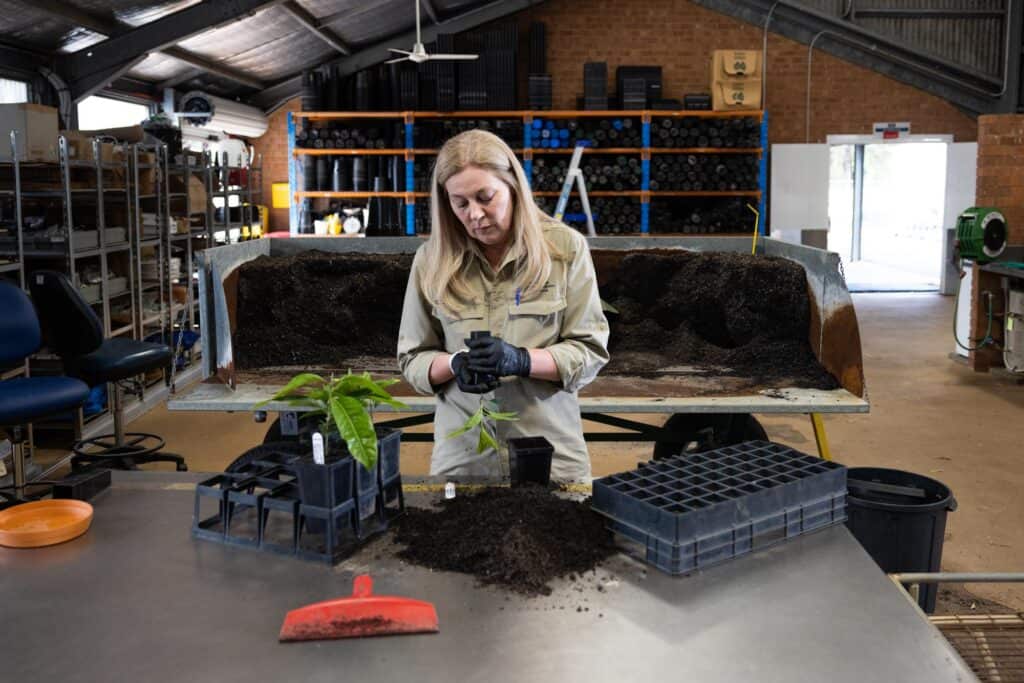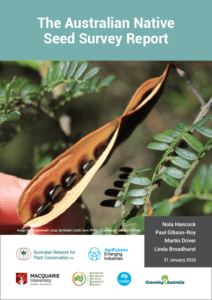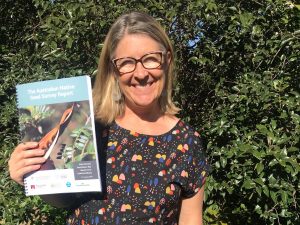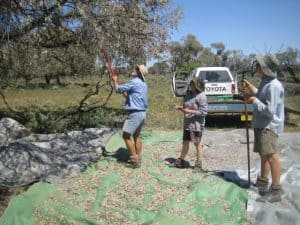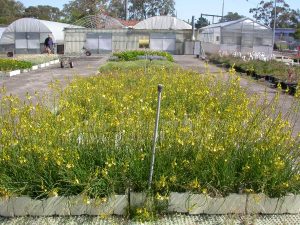
Apr 24, 2023 | Media Releases, News
Native Guava (Rhodomyrtus psidioides) was a common and widespread native plant before Myrtle Rust was introduced to Australia in 2010. However, this native rainforest tree has suffered catastrophic declines as a result of this pathogen.
Few adult trees now survive, and the species is mainly hanging on through old root systems that put up annual suckers, which are also killed by Myrtle Rust.
Because of this, Native Guava is now listed as Critically Endangered under Commonwealth, New South Wales and Queensland legislation. It is one of 30 priority plant species listed in the Australian Government’s Threatened Species Strategy Action Plan 2021-2026.
The Australian Network for Plant Conservation has led the ‘Safe Custody for Native Guava‘ project over the past 12 months. We wanted to create more robust insurance collections of this species and show how a cross-State response could conserve the species.
Dr Amelia Martyn Yenson, who led this project, believes working together was essential when piloting a dispersed-custody model.
“Sharing the responsibility of caring for Native Guava plants means there is less risk of losing valuable genetic diversity; it’s also been an effective way to share information about Myrtle Rust, its impact and management.”
The ANPC has been at the centre of attempts by concerned scientists and conservation practitioners to develop a coordinated and funded national response to Myrtle Rust.
The recent outbreak of Myrtle Rust on Lord Howe Island, a World Heritage Area, has highlighted the urgency of protecting native plants from extinction.
-ends-
The Australian Network for Plant Conservation Inc. (ANPC) is a not-for-profit organisation that promotes and develops plant conservation in Australia.
For more information please contact:
Bob Makinson, ANPC Outreach Delegate and Myrtle Rust team member
Phone number: 0458 411 055
Email: Robert.Makinson@environment.nsw.gov.au

Phil Hurle monitoring plants at the Australian National Botanic Gardens (Credit Zoe Knapp)

Peter Gould with Native Guava at Lismore Rainforest Botanic Garden (Credit Michael Lawrence-Taylor).

Veronica Viler propagating plants at the Australian Botanic Garden Mount Annan (Credit Michael Lawrence-Taylor)

Mar 31, 2020 | Media Releases
New report highlights the concerns of the native seed sector that future demand will be difficult to meet.
Download the The Australian Native Seed Survey Report here.
 Our unique native plant ecosystems are critical habitat for native animals and essential in mitigating the impacts of climate change and extreme weather events.
Our unique native plant ecosystems are critical habitat for native animals and essential in mitigating the impacts of climate change and extreme weather events.
High quality seed from a range of native species is the foundation for restoring many of our threatened plants and natural landscapes, particularly those unable to regenerate after the catastrophic bushfires of the past summer, or that are otherwise especially vulnerable.
The people who collect, purchase and use this seed are a critical part of an industry which faces many challenges, including dwindling seed supplies, continued loss and fragmentation of native vegetation, declining expertise and training, low levels of funding and the increasingly severe impacts of climate change (to name but a few).
To address these challenges, the Australian Network for Plant Conservation (ANPC) undertook the Australian Native Seed Survey in 2016-2017 to better understand the native seed sector and its ability to meet current and future demand.

Threatened Species Commissioner Sally Box launching the ANPC’s The Australian Native Seed Survey Report.
The Australian Native Seed Survey Report, launched today by the Threatened Species Commissioner Dr Sally Box, details the full results of this national survey capturing the behaviours and views of a wide range of sector participants – which the four authors (listed below) say are not all encouraging.
‘Worryingly, the report highlights the concerns of the sector that future demand for seed will be difficult to meet from the wild’ said Martin Driver from the ANPC.
‘This is due to the high costs of seed collection and the lack of seed from a broad range of the species that are critical for restoration. The recent bushfires have made this situation worse’.
The report identifies that there may not be enough native seed in many areas to support the large-scale restoration required for landscape recovery. It also outlines many of the issues that need to be addressed in future restoration programs.
Seed production of native seed offers some hope, but currently lacks the capacity to meet demand.
‘Seed production areas (SPAs) are an increasingly important supplier of seed for restoration, landscaping and bush food markets’ said Dr Paul Gibson-Roy from Kalbar Resources.
‘SPAs are locations where we cultivate native species for their seeds, like agricultural crops. They can produce seed in higher quantities and quality that is much easier to collect than in the wild. Their continued development will be critical to meeting seed needs and preserving wild populations’.
The report’s findings and eleven prioritised recommendations will assist governments to develop policies and plans to help the native seed sector grow and thrive, and meet the demand for quality seed into the future. This will ultimately help restore Australia’s unique ecosystems and precious threatened plants.
Download the The Australian Native Seed Survey Report here.
The Australian Native Seed Survey Report was released as part of the NSW Government funded Healthy Seeds Project which aims to deliver an evidence-based Roadmap to secure a reliable, genetically-appropriate native seed supply in NSW, and update the Florabank Guidelines for best-practice native seed collection and use. An audit of past and current SPAs has recently commenced under the Project to help guide the establishment of better-funded and strategic SPAs in the future. Find out more at the Healthy Seeds webpage here https://www.anpc.asn.au/healthy-seeds/.

Collecting Boree (Acacia pendula) seed for restoration. (Photo: Martin Driver)
Media support enquiries
Jo Lynch
Business Manager, Australian Network for Plant Conservation Inc.
Email
Contact details for The Australian Native Seed Survey Report authors for comment:
Dr Paul Gibson-Roy
Manager Ecological Restoration, Kalbar Resources
Email
Martin Driver
Project Manager, Australian Network for Plant Conservation Inc.
Email

Wildflower seed production boxes at Melbourne University with Bulbine Lilies (Bulbine bulbosa) in the foreground. (Photo: Paul Gibson-Roy)
Dr Linda Broadhurst
Director, Centre for Australian National Biodiversity Research (CSIRO National Research Collections Australia)
Email
Nola Hancock
Research Fellow, Macquarie University
Email
Healthy Seed Project Partners
Australian Association of Bush Regenerators
Australian Seed Bank Partnership
Centre for Australian National Biodiversity Research
Greening Australia
NSW Government
Society for Ecological Restoration
The Royal Botanic Garden Sydney
